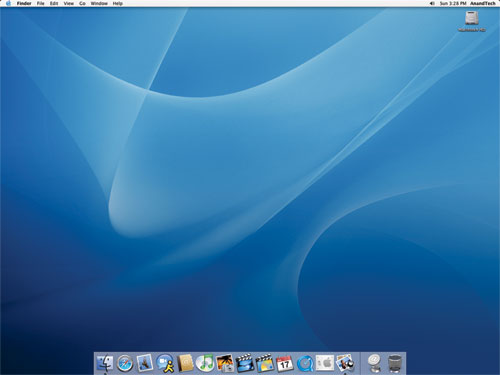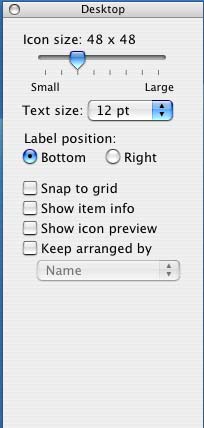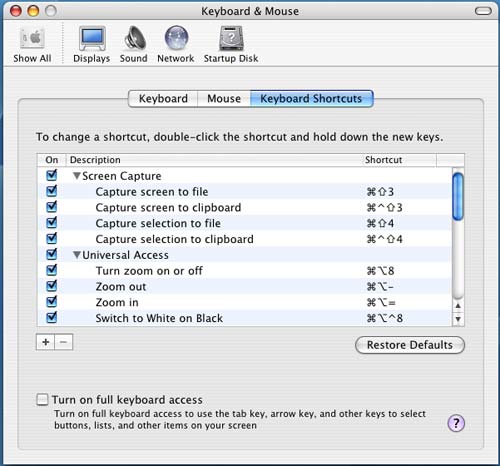A Month with a Mac: A Die-Hard PC User's Perspective
by Anand Lal Shimpi on October 8, 2004 12:05 AM EST- Posted in
- Mac
Finding my way around Finder
The OS X desktop is clearly different from what I was used to under XP. For starters, all of the icons have been moved to the right side of the screen; and where I was used to seeing a taskbar, there was this little translucent "dock" with a bunch of icons in it.
The OS X desktop and features, such as icon size, dock size and animations, are easily customizable.
Click to enlarge.
Under Windows, there is Explorer. It is the application that not only exists as a way of browsing your file system, but also as the "desktop" itself; the OS X equivalent? Finder. I don't think that I have to point out the similarity in the names. Yes, one company copied (or poked fun at) another.
My first reaction was that the icons on the desktop were far too large; indeed, they are, if you put them on a Windows desktop - but for some reason, they end up looking strange if you make them smaller. One of the biggest features of OS X is the ability to customize just about every aspect of the OS; I didn't like the size of the icons at first, so I simply changed the icon size through the "view options" menu. Although it's easy to talk about now, I had to ask how to do it online before I ever discovered the option - also the case with the majority of OS X, most of the power and customization of the OS remains hidden. I quickly realized that although Apple had targeted the entry level computer user with the interface of OS X, the OS was far more tailored to the power user in my opinion.

Where to start? Customization is much more possible (and easy to do) under OS X than any variant of Windows that I have ever encountered. Icon sizes are just the beginning; through the view options menu alone, you can change the positioning of the labels on the icons, the text size as well as the normal array of Windows options. And any changes you make here occur in real time - no clicking "OK" or "Apply". Just check a box and it happens instantaneously; and uncheck it, and everything goes back to normal. It's a small thing, but as I soon found out, much of OS X's appeal to me came in tiny gems like this.
The other thing to point out, which is quite possibly the biggest draw to OS X for me, is the fact that just about everything under OS X has a keyboard shortcut associated with it. I've found that if you got your start with PCs in the DOS days, then you end up being much more of a keyboard junkie than someone who is reliant on the mouse. I use the mouse when I have to, but when it's quicker to use the keyboard, I feel much more comfortable firing off a few keystroke combinations to get my point across. If you are anything like me in that respect, then OS X will be your playground.
I can't possibly list all of the keystroke combinations that I use on a daily basis, but there are quite a few. For example, I am a big "ALT-TAB"-er in Windows, but ALT-TAB is only really useful for switching applications, not closing them. The ALT-TAB equivalent under OS X, Command-TAB (the Command key is positioned where you'd expect ALT to be, so it works out fine), works similarly, but here's the catch - hit "Q" while you've selected an application and it will quit automatically. Nice, but nothing major right?
Want to minimize a window? Command-M will take care of that. Want to hide an application without minimizing it? Command-H. Hidden windows will automatically move to the end of the Command-TAB list, so you don't switch to them after you've hidden them.
Want to open a new Finder window? Command-N. Want to create a new folder on your drive? Shift-Command-N. I've always wanted to be able to create new folders in Explorer without using the mouse. OS X was a dream come true in that respect.
OS X will even let you define your own keyboard shortcuts for any application through the keyboard preferences panel:

Not impressed? Not a keyboard junkie? Then Finder is just as capable and as usable as Explorer. No big win for Apple there, but maybe a draw. For me, the little things are what intrigued me, but I'll admit - not everyone is as easily amused!
There is one aspect of the keyboard shortcut support that OS X does fall behind on, and that is support for keyboard shortcuts in dialog boxes. In some dialog boxes, hitting Command and the letter of the option you want to select will work, but in others, it will not. Furthermore, finding out the correct key to hit to select the option that you want is most definitely a guessing game, as there are no underlined characters or anything indicating what key to hit. Given OS X's strong support for keyboard shortcuts, this shortcoming (no pun intended) is puzzling.










215 Comments
View All Comments
addragyn - Friday, October 8, 2004 - link
RE: Safari's SpeedThere is a delay built into the browser.
You can reduce it - http://www.oreillynet.com/pub/wlg/4924
David Hyatt is a Safari developer @ Apple, he covered this on his blog - http://weblogs.mozillazine.org/hyatt/archives/2004...
Zak - Friday, October 8, 2004 - link
The biggest problem with the article I sa so far is overlooking the iApps. Also, the apps equivalents are not correct. Entourage is Outlook counterpart and there is Acrobat Reader for OSX as well. Other than that it's a good article, but it's clear that Anand missed some things and got some others wrong, like the mentioned mouse cable, etc.Zak
azkman - Friday, October 8, 2004 - link
This was a very good editorial/experience piece. Compared to other articles by Windows-users trying Macs, it was very open-minded. However, I have to agree with some of the earlier posters. The hardware used was dated, and the reviewer did not mention some of the key strengths of the Mac platform.It seems to me that Windows-users are fixated on certain characteristics and define a computer by MHz, framerate, etc, and this came out to a certain degree in the review. The author readily admits that he is used to writing hardware pieces for this type of audience, and again, I applaud him for his open-mindedness.
Here is some information for posters and readers who want to learn more about Apple's computers and understand the overall value equation:
price - http://www.linuxinsider.com/story/36120.html
performance - http://www.linuxinsider.com/story/36964.html
proof - http://www.tcf.vt.edu/systemX.html
http://www.colsa.com/cover_page/news_front/news_de...
http://www.top500.org/list/2003/11/
http://www.roanoke.com/news/roanoke%5C6133.html
http://www.pcmag.com/review/0%2C2491%2Cs%3D1564&am...
http://www.pcmag.com/article2/0,1759,1369037,00.as...
Applications & tools included in the price (beyond normal MS Windows offerings):
video conferencing (high quality, easy to set-up, easy to use)
music creation
jukebox / music management / cd burning
photo management
movie editing
dvd authoring & burning
all-purpose search tool
PDF export from any printable page
font management
full development environment (c, c++, objective c, java, scripting...)
full unix shell, w/ x11
Yes, I know a few of these applications are included with Windows, but I work in a tech-savvy Windows-dominant company and none of my co-workers use the bundled programs. In fact, most of them don't video conference or edit videos.
Anyway, the Mac is really an "experience" in that the traditional concept of a computer disappears and the Mac becomes an extension of what the user wants to do. That is of course unless the user wants to work specifically with Windows issues. The value of a Mac comes from its ability to empower the user to do terrific things straight out of the box without thinking about things like viruses and security while also being a supercomputer-class piece of equipment.
rxmz - Friday, October 8, 2004 - link
Thanks, very good article.I agree with some earlier posts that the Unix aspect of Mac OS X is a big advantage over Windows. I have a company web server and mail server (with IMAP and web mail access) running on the same G4 tower that is used as a desktop (not an ideal setup, I know, but it has to suffice for now ;-). I have PostgreSQL, cvs, and Subversion installed on my PowerBook. I can ssh to the office to administer the mail or web server. The Unix foundation is a terrific aspect of the OS.
Anand, you might want to take a look at Camino for web browsing. And if you have a chance, check out the capabilities of AppleScript; it's cool now and only going to get more accessible to non-power users when Tiger comes out.
mjtomlin - Friday, October 8, 2004 - link
oops one other point to make on the GUI responsiveness ...OS X GUI is timed. Things happen at a constant rate based on time not on CPU speed ... a lot of bench-markers like to use the scrolling test ... to see which system is faster. This is not a vaild test, because Mac OS X times the speed. This is actually a feature of the system. The whole point of scrolling was to quickly skim through a document. If the system scrolls through the document too fast, how do you know what you're missing?
A lot of the GUI is designed like this ... that is, someone actually thought about the purpose of the feature and made sure it remained useful.
To get to the end of a document, just drag the scroll bar down to the bottom or press the "end" key on the keyboard ... you'll be there in less than a second, that was those were designed for.
mjtomlin - Friday, October 8, 2004 - link
A couple of points...#1 - i thought it was a fairly good article. You have to remember he was not writing a definitive guide to OS X/PowerMac. This was his take on the system from a Windows user perspective. There is obviously going to be a lot of details left out and many misunderstood "features"
#2 - poster #60 regarding patching security issues... Apple has been releasing security fixes for OS X ever since it was released. I believe we're up to a couple a month in fact. Most OS X users update their systems without incident and continue on... The biggest difference between OS X security patches and those for Windows is that all the security fixes for OS X are for issues that have NOT been exploited yet.
THERE WILL ALWAYS BE SECURITY ISSUES IN ANY OPERATING SYSTEM.
But because of OS X's open source base (Darwin/BSD) most security issues are discovered before they're ever exploited. The opposite of this is true under Windows.
#3 Dual CP's are not necessarily faster than a single CPU ... You have to remember, this is only true if the application that you're running is multi-threaded. And the OS itself is highly tuned for multi-tasking.
The GPU in the PowerMac does the screen drawing, so it doesn't make a difference how many CPU's are in the system.
#4 GUI responsiveness ... OS X using buffering to draw the GUI, Windows does not. This is obvious as seen under slower systems when trying to move windows around... XP will leave screen "artifacts" (garbage) ... OS X windows appear to "jerk" and "jump"
the end.
shuste73 - Friday, October 8, 2004 - link
I'm a Linux user (Slackware), and one of the biggest challenges to Linux continues to be the very people that are trying to promote it - poor, misguided zealots that reflect poorly on the entire community.Judging from the feedback to this article, I see that the Mac users are generally no different. It's a shame.
I thought the article was very good, personally, from the perspective of a long-time Microsoft user-turned-Slacker.
indd - Friday, October 8, 2004 - link
Although this is experiential writing I'm really surprised at the understatement of the difference between the OS's. The effort Apple has put into usability results in a very solid feel for the OS. Windows really feels very unsophisticated in comparison, especially in error handling.Which brings me to the fact that I'm disappointed to see the page on crashing so glossed over. Need examples of the Mac crashing to back it up! It really appeared like something was omitted here.
Reading the article leaves me with the feeling he really loves Windows, and still brought a lot of old anti-mac feelings into the experience. I don't want to sound harsh here, just relating my reactions to the article.
At least he tried :)
asimuth - Friday, October 8, 2004 - link
One of the hardest things I have ever tried to do was explain to someone why I use a Mac and why it is a different experience. In the end the explanation always comes down to "it is the little things". Your article was the best review I have read. You had a clearly stated experiential bias and you refused to let past predjudices get in the way of a thgoughful review.As a softcore geek I am disappointed that my platform of choice did not knock it out of the ballpark for you. Having said that, I think your criticisms are very valid. I will certainly want to refer people to this article to give them some idea of why I'm a Mac user.
In my working life I am the development manager for a small software company - windows only. You cannot imagine how frustrating it is to be without the small thoughtful additions that make my OSX experience.
: )
BopTop - Friday, October 8, 2004 - link
Great article, I haven't touched an apple computer since the powerpc days.An article like this will always have detractors, that apple hardware and pc hardware weren't comparable, dual cpu or single, etc. All I can say is re-read the first page - this wasn't to compare hardware, or really software. It was to compare the "experience" of using a system that has a different work method.
That's exactly what the article did, and did it excellently.